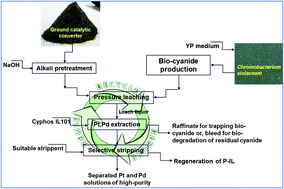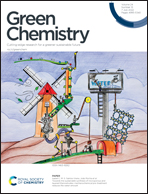Mobilization of platinum and palladium from exhausted catalytic converters using bio-cyanide and an ionic-liquid as mass transport carriers†
Abstract
The present study investigated the resource circulation of precious metals (Pt and Pd) from exhausted catalytic-converters using a green integrative approach of bio-solvo-chemical techniques. Herein, the used biogenic cyanide as a lixiviant medium was produced via the oxidative decarboxylation of glycine during the late exponential growth phase of Chromobacterium violaceum. The advantage of microbial activity was utilized in two-fold: (i) in situ production of the bio-cyanide lixiviant and (ii) bio-destruction of residual cyanide from the Pt/Pd-depleted bleed solution. More than 95% of Pt and Pd were efficiently dissolved in bio-cyanide solution by autoclaving under the optimized condition of temperature, 150 °C; pO2, 14 bar; and time, 120 min. Furthermore, the solvo-chemical extraction of the Pt/Pd-cyanide complex was performed using a green ionic-liquid solvent (Cyphos IL101). The parametric studies revealed that >96% Pt and Pd were extracted under the optimal conditions of ionic-liquid concentration, 0.15 mol L−1; extraction pH, 10.4; and temperature, 20 °C. The extraction thermodynamics yielded negative values of enthalpy changes (i.e.,  , −39.8 kJ mol−1 and
, −39.8 kJ mol−1 and  , −34.9 kJ mol−1), which indicated the exothermic characteristics of outer-sphere coordination between the ionic-liquid and Pt/Pd(CN)42− compounds. Subsequently, an excellent selectivity on Pd and Pt stripping from the loaded organic phase was achieved by sequential contact with 2.0 mol L−1 NH4SCN and 1.5 mol L−1 S(CH2CH2OH)2 solutions. The tested recyclability of cyanide-bearing raffinate, regeneration and reusability of the ionic-liquid, and bio-degradation of cyanide-bleed solution drive the process towards zero-discharge of toxic substances. Significantly low-emission exploitation of precious metals (reduced from 10.8 × 106 to only 1.63 t CO2-e) from the waste materials with a sustainable process index value of 0.0145 cap per kg reveals that the process is suitable for sustainable development.
, −34.9 kJ mol−1), which indicated the exothermic characteristics of outer-sphere coordination between the ionic-liquid and Pt/Pd(CN)42− compounds. Subsequently, an excellent selectivity on Pd and Pt stripping from the loaded organic phase was achieved by sequential contact with 2.0 mol L−1 NH4SCN and 1.5 mol L−1 S(CH2CH2OH)2 solutions. The tested recyclability of cyanide-bearing raffinate, regeneration and reusability of the ionic-liquid, and bio-degradation of cyanide-bleed solution drive the process towards zero-discharge of toxic substances. Significantly low-emission exploitation of precious metals (reduced from 10.8 × 106 to only 1.63 t CO2-e) from the waste materials with a sustainable process index value of 0.0145 cap per kg reveals that the process is suitable for sustainable development.



 Please wait while we load your content...
Please wait while we load your content...